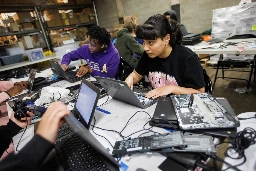Built-in software ‘death dates’ are sending thousands of schools’ Chromebooks to the recycling bin
Built-in software ‘death dates’ are sending thousands of schools’ Chromebooks to the recycling bin

Doubling the lifespan of older Chromebooks would save California’s schools $225 million, according to advocacy group CALPIRG.

There are few things quite as emblematic of late stage capitalism than the concept of "planned obsolescence".
